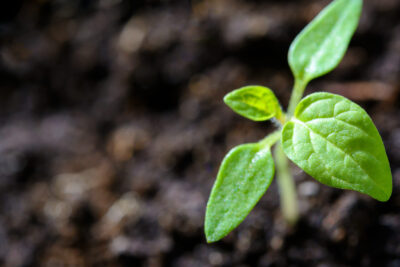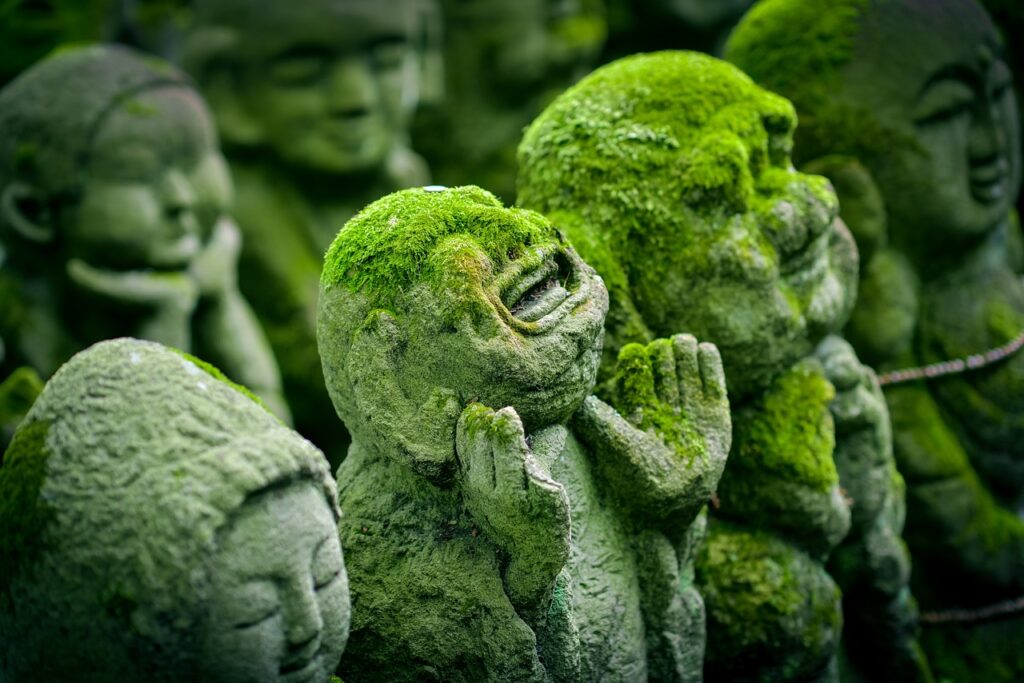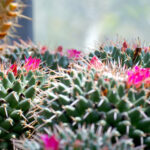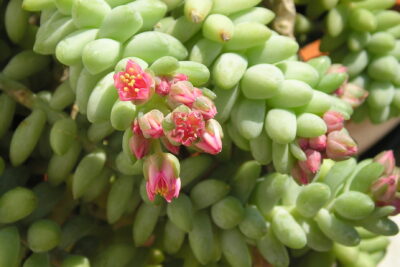
Discover the Perfect Buddha Temple Succulent for Your Home

The calming and serene presence of Buddha statues and imagery has long been associated with inner peace and spiritual enlightenment. For those looking to bring a touch of tranquility into their homes, the Buddha temple succulent is the perfect addition. These unique plants combine the beauty of traditional Buddha statues with the vibrant greenery of succulents, creating a harmonious blend of spirituality and nature.
We will delve into the world of Buddha temple succulents and explore their symbolism, care requirements, and design potential. We will discuss the different types of Buddha temple succulents available, including the popular Jade Buddha and Laughing Buddha varieties. Additionally, we will provide tips on how to care for these plants, including watering and sunlight needs. Whether you are a seasoned plant enthusiast or a beginner looking to add some zen to your space, this article will provide all the information you need to find and care for the perfect Buddha temple succulent for your home.
- Research different types of Buddha Temple Succulents online
- Visit local plant nurseries and garden centers to find a variety of options
- Ask for recommendations from friends or family members who have Buddha Temple Succulents
- Consider the size and space available in your home before choosing a Buddha Temple Succulent
- Choose a Buddha Temple Succulent with the right lighting requirements
- Consider the maintenance and care required for your Buddha Temple Succulent
- Add some personality with different Buddha Temple Succulent varieties
- Conclusion
- Check the care instructions for each type of Buddha Temple Succulent to ensure it fits your lifestyle
- Consider the lighting requirements of different Buddha Temple Succulents and choose one that matches your home's natural light conditions
- Look for Buddha Temple Succulents that have interesting shapes or colors to add visual interest to your home
- Consider the level of maintenance required for each type of Buddha Temple Succulent and choose one that fits your schedule and gardening abilities
- Don't be afraid to mix and match different types of Buddha Temple Succulents to create a unique and diverse display in your home
- Finally, enjoy the process of finding the perfect Buddha Temple Succulent for your home and have fun caring for it.
- Research different types of Buddha Temple Succulents online.
- Visit local plant nurseries and garden centers to find a variety of options.
- Ask for recommendations from friends or family members who have Buddha Temple Succulents.
- Consider the size and space available in your home before choosing a Buddha Temple Succulent.
- Check the care instructions for each type of Buddha Temple Succulent to ensure it fits your lifestyle.
- Check the care instructions for each type of Buddha Temple Succulent to ensure it fits your lifestyle.
- Consider the lighting requirements of different Buddha Temple Succulents and choose one that matches your home's natural light conditions.
- Look for Buddha Temple Succulents that have interesting shapes or colors to add visual interest to your home.
- Look for Buddha Temple Succulents that have interesting shapes or colors to add visual interest to your home.
- Consider the level of maintenance required for each type of Buddha Temple Succulent and choose one that fits your schedule and gardening abilities.
- Don't be afraid to mix and match different types of Buddha Temple Succulents to create a unique and diverse display in your home.
- Finally, enjoy the process of finding the perfect Buddha Temple Succulent for your home and have fun caring for it
- Frequently Asked Questions
Research different types of Buddha Temple Succulents online
If you are looking to add a touch of tranquility and spirituality to your home, a Buddha Temple Succulent is the perfect choice. These unique plants not only bring a sense of peace and serenity but also add a touch of elegance to any space. To find the perfect Buddha Temple Succulent for your home, start by researching different types online.
When it comes to Buddha Temple Succulents, there are various types available, each with its own distinct features and characteristics. By researching online, you can explore the wide range of options and find the one that resonates with you the most.
Why research online?
Researching different types of Buddha Temple Succulents online allows you to access a wealth of information at your fingertips. You can browse through various websites, blogs, and online forums dedicated to succulent enthusiasts. This will help you gather valuable insights, tips, and recommendations from experienced growers and enthusiasts.
Additionally, online research allows you to view images of different Buddha Temple Succulents, giving you a visual idea of how they would look in your home. You can also find information on their care requirements, ideal growing conditions, and potential challenges you may encounter.
Where to start?
A good starting point for your online research is to search for reputable nurseries or online stores that specialize in succulents. These sources often provide detailed descriptions of each Buddha Temple Succulent variety, including their size, color, growth patterns, and unique characteristics.
 Best Pink Flowering Ground Cover Succulents for Your Garden
Best Pink Flowering Ground Cover Succulents for Your GardenMake sure to read customer reviews and ratings to get an idea of the overall satisfaction and success rate of growing each type of succulent. This will help you gauge whether a particular Buddha Temple Succulent is suitable for your skill level and the conditions in your home.
Considerations for choosing a Buddha Temple Succulent
Before making a final decision, there are a few factors to consider. Firstly, assess the lighting conditions in your home. Some Buddha Temple Succulents thrive in bright, indirect light, while others prefer partial shade. Choose a variety that matches the lighting conditions you can provide.
Next, consider the space you have available. Buddha Temple Succulents come in various sizes, from small and compact to larger, more statement-making plants. Consider the available space and choose a size that fits well without overwhelming the area.
Finally, think about your personal aesthetic preferences. Buddha Temple Succulents come in a range of colors, leaf shapes, and textures. Some have intricate patterns or variegation, while others have a more minimalist appearance. Choose a variety that resonates with your style and complements the overall ambiance of your home.
Conducting online research is an essential step in finding the perfect Buddha Temple Succulent for your home. It allows you to gather information, explore different varieties, and make an informed decision based on your preferences and the conditions in your living space.
Visit local plant nurseries and garden centers to find a variety of options
When it comes to finding the perfect Buddha Temple succulent for your home, visiting local plant nurseries and garden centers is a great way to explore a variety of options. These establishments often have a wide selection of succulents, including the popular Buddha Temple variety.
At these nurseries and garden centers, you can find a range of sizes and shapes of Buddha Temple succulents. Some may have tall and slender stems, while others may be more compact and bushy. Take your time to browse through the different options and choose the one that best fits your preferences and the available space in your home.
 10 Unique Indoor Succulents That Resemble Hair for a Whimsical Touch
10 Unique Indoor Succulents That Resemble Hair for a Whimsical TouchConsider the lighting conditions in your home
Before making your final selection, it's important to consider the lighting conditions in your home. Buddha Temple succulents thrive in bright, indirect light. They should be placed near a window where they can receive bright but filtered sunlight throughout the day. If you have a room with ample natural light, that would be an ideal spot for your Buddha Temple succulent.
If you don't have a well-lit room, don't worry! Buddha Temple succulents are known for their adaptability and can tolerate lower light conditions. However, it's best to avoid placing them in dark corners or areas with minimal sunlight, as this can cause them to become leggy and lose their compact shape.
Choose the right pot and soil
When it comes to potting your Buddha Temple succulent, it's important to choose a container with good drainage. Succulents, including the Buddha Temple variety, are susceptible to root rot if their roots sit in waterlogged soil for too long. Opt for a pot with drainage holes at the bottom to ensure excess water can escape.
In terms of soil, Buddha Temple succulents prefer a well-draining mix. You can either purchase a specialized succulent potting mix or create your own by mixing equal parts of potting soil, perlite, and coarse sand. This type of soil will prevent water from pooling around the roots and help maintain the health of your succulent.
Provide proper care and maintenance
To keep your Buddha Temple succulent thriving, it's important to provide it with proper care and maintenance. Here are a few tips:
- Watering: Buddha Temple succulents are drought-tolerant and prefer to be slightly underwatered rather than overwatered. Allow the soil to dry out completely between waterings and ensure that excess water drains out of the pot.
- Lighting: As mentioned earlier, these succulents love bright, indirect light. Place them near a window where they can receive ample sunlight throughout the day.
- Temperature and humidity: Buddha Temple succulents thrive in average room temperatures between 65-75°F (18-24°C). They can tolerate slightly lower temperatures but should be kept away from cold drafts. Additionally, they prefer low humidity levels.
- Fertilizing: Feed your Buddha Temple succulent with a balanced, water-soluble fertilizer during the growing season (spring and summer) to promote healthy growth. Follow the instructions on the fertilizer packaging for the correct dosage.
By following these guidelines and providing your Buddha Temple succulent with the right conditions and care, you can enjoy its unique beauty and bring a touch of tranquility to your home.
Ask for recommendations from friends or family members who have Buddha Temple Succulents
 Top 10 Tall Succulent Plants: Perfect for Indoor or Outdoor Use
Top 10 Tall Succulent Plants: Perfect for Indoor or Outdoor UseIf you're looking to add a touch of serenity and spirituality to your home, a Buddha Temple Succulent might be the perfect choice. These unique plants not only bring a sense of tranquility to any space but also serve as a beautiful reminder of the Buddhist philosophy. However, finding the right Buddha Temple Succulent for your home can be a daunting task. That's why it's always a good idea to ask for recommendations from friends or family members who already have these plants.
Getting advice from someone who has experience with Buddha Temple Succulents can be invaluable. They can give you insights into the care and maintenance of these plants, as well as suggestions on where to find the best varieties. Plus, they may even be able to provide you with cuttings or plant divisions, which can be a cost-effective way to start your own collection.
When asking for recommendations, be sure to inquire about their favorite varieties and why they love them. Some people may prefer Buddha Temple Succulents with larger leaves, while others may prefer ones with unique shapes or colors. By gathering this information, you'll be able to narrow down your choices and find the perfect Buddha Temple Succulent that resonates with you.
Remember to take note of any care tips or special considerations that are mentioned. Buddha Temple Succulents have specific requirements in terms of sunlight, watering, and soil type, so understanding these needs is crucial for their long-term health. Your friends or family members can provide you with valuable insights that will help you create the ideal growing conditions for your new plant.
Lastly, if you don't know anyone personally who owns Buddha Temple Succulents, you can also turn to online communities and forums. There are plenty of passionate succulent enthusiasts who are more than willing to share their knowledge and recommendations. Just make sure to verify the credibility of the sources and cross-reference the information to ensure accuracy.
By asking for recommendations and advice, you're not only gaining valuable insights but also tapping into a community of fellow plant lovers who share your passion. So don't hesitate to reach out, as you never know what kinds of discoveries and connections you might make along the way!
Consider the size and space available in your home before choosing a Buddha Temple Succulent
When it comes to choosing the perfect Buddha Temple Succulent for your home, one of the first factors to consider is the size and space available. These succulents come in a variety of sizes, ranging from small desk plants to larger floor plants.
 Exploring Fred Ives: A Specialist in Succulent Cultivation
Exploring Fred Ives: A Specialist in Succulent CultivationIf you have limited space, a smaller Buddha Temple Succulent would be ideal. They can be placed on a desk, countertop, or windowsill, adding a touch of tranquility to any room without taking up too much space. On the other hand, if you have a larger area to work with, you may opt for a larger Buddha Temple Succulent that can be placed on the floor or on a plant stand.
Additionally, consider the overall aesthetics of your home. A smaller Buddha Temple Succulent can be a great addition to a minimalist or modern decor, while a larger succulent can make a statement in a more spacious and eclectic setting.
Choose a Buddha Temple Succulent with the right lighting requirements
Another important aspect to consider when selecting a Buddha Temple Succulent is its lighting requirements. These plants typically thrive in bright, indirect light, making them perfect for well-lit areas in your home.
If you have a room with ample natural light, such as a sunny living room or a bright kitchen, a Buddha Temple Succulent will flourish in such an environment. However, if you have a darker space, you might want to consider placing your succulent near a window where it can still receive some indirect sunlight.
Remember, direct sunlight can be too harsh for these plants and may cause sunburn or damage to their leaves. It's always a good idea to observe your home's lighting conditions before bringing a Buddha Temple Succulent home.
Consider the maintenance and care required for your Buddha Temple Succulent
Like any plant, Buddha Temple Succulents require some level of care and maintenance. However, compared to other houseplants, they are generally quite low-maintenance.
These succulents are adapted to survive in arid conditions, so they have excellent water storage capabilities. As a result, they don't require frequent watering. In fact, overwatering can be detrimental to their health. It's best to allow the soil to dry out between waterings and only water when the top inch of soil feels dry to the touch.
 Top Succulents with White Hair: A Guide to the Best Varieties
Top Succulents with White Hair: A Guide to the Best VarietiesIn terms of fertilization, Buddha Temple Succulents do not need to be fertilized frequently. A balanced, diluted succulent fertilizer can be applied once or twice a year during the growing season to provide the necessary nutrients.
Furthermore, these succulents prefer well-draining soil and pots with drainage holes to prevent waterlogging. It's essential to choose a suitable potting mix specifically designed for succulents to ensure optimal growth and prevent root rot.
Add some personality with different Buddha Temple Succulent varieties
One of the most exciting aspects of Buddha Temple Succulents is the wide variety of species and cultivars available. Each variety has its unique characteristics, including different leaf shapes, colors, and textures.
Consider adding some personality to your home by selecting Buddha Temple Succulents with different varieties. Some popular choices include the Crassula Ovata (Jade Plant) with its vibrant green leaves, the Echeveria species with their rosette-shaped foliage, or the Haworthia Cooperi with its translucent leaves.
By mixing and matching different varieties, you can create a visually appealing display that reflects your personal taste and style.
Conclusion
Choosing the perfect Buddha Temple Succulent for your home involves considering factors such as size, lighting requirements, maintenance, and personal preference. By carefully evaluating these aspects, you can find a Buddha Temple Succulent that not only complements your home's decor but also thrives in its environment.
Check the care instructions for each type of Buddha Temple Succulent to ensure it fits your lifestyle
 Top 10 Succulents That Flourish in Partial Sunlight: A Guide
Top 10 Succulents That Flourish in Partial Sunlight: A GuideWhen it comes to choosing the perfect Buddha Temple Succulent for your home, it's important to consider the care instructions for each type. Different succulent varieties have unique needs and requirements, so it's essential to choose one that fits your lifestyle and the conditions in your home.
Here are some key factors to consider when checking the care instructions:
- Light requirements: Some Buddha Temple Succulents thrive in bright, direct sunlight, while others prefer indirect or filtered light. Make sure to select a succulent that matches the lighting conditions in your home.
- Watering frequency: Each type of Buddha Temple Succulent has different water needs. Some varieties require more frequent watering, while others are more drought-tolerant. It's crucial to understand the watering requirements to avoid overwatering or underwatering your succulent.
- Temperature and humidity: Consider the temperature and humidity levels in your home. Certain Buddha Temple Succulents are more suited to warm and humid environments, while others can tolerate cooler temperatures. Ensure the succulent you choose can thrive in your specific climate.
- Soil type and drainage: Succulents generally prefer well-draining soil to prevent root rot. Check the care instructions to see if the specific Buddha Temple Succulent requires any special soil mix or additional drainage measures.
- Fertilizing: Some succulents benefit from occasional fertilization to promote growth and flowering. Verify if the Buddha Temple Succulent you're interested in requires any specific fertilizing schedule or type of fertilizer.
By thoroughly reviewing the care instructions for each type of Buddha Temple Succulent, you can ensure that you choose a plant that aligns with your lifestyle and that you can provide the necessary care it needs to thrive. Remember, a well-cared-for succulent will not only enhance the beauty of your home but also bring a sense of tranquility and serenity.
Consider the lighting requirements of different Buddha Temple Succulents and choose one that matches your home's natural light conditions
When it comes to choosing the perfect Buddha Temple Succulent for your home, one important factor to consider is the lighting requirements of different varieties. Succulents, in general, thrive in bright light conditions, but the specific needs may vary from one type to another.
If your home receives ample natural light throughout the day, you have a wide range of options to choose from. Succulents like Echeverias, Haworthias, and Jade plants are known to thrive in bright, indirect light. These varieties will be perfect for placing near a sunny window or in a well-lit room.
However, if your home lacks natural light or you want to add greenery to a room with limited sunlight, there are still plenty of beautiful succulents that can adapt to lower light conditions. Snake plants, ZZ plants, and Haworthia attenuata are all great choices that can tolerate low light environments and still add a touch of nature to your living space.
Remember to assess the lighting conditions in different areas of your home before selecting a Buddha Temple Succulent. Observing the intensity and direction of natural light throughout the day will help you determine which varieties will thrive and bring the most beauty to your space.
 Exploring the Beauty of Sedum Sunset Succulent: A Comprehensive Guide
Exploring the Beauty of Sedum Sunset Succulent: A Comprehensive GuideConsider the watering needs of Buddha Temple Succulents and establish a proper watering routine
Watering is a crucial aspect of caring for Buddha Temple Succulents. These plants are adapted to survive in arid environments, which means they are not fond of excessive moisture. Overwatering can lead to root rot and other issues, so it's important to establish a proper watering routine.
Most Buddha Temple Succulents prefer a "soak and dry" method of watering. This means thoroughly watering the plant until water drains out of the bottom of the pot, and then allowing the soil to dry out completely before watering again. This mimics the natural rainfall patterns in their native habitats.
It's essential to always check the moisture levels of the soil before watering your succulents. Stick your finger about an inch into the soil, and if it feels dry, it's time to water. Avoid watering on a fixed schedule, as the frequency may vary depending on factors such as the temperature, humidity, and the size of the pot.
Remember, it's better to underwater than overwater your Buddha Temple Succulents. These plants have adapted to store water in their leaves and stems, so they can withstand periods of drought. By providing the right amount of water and allowing the soil to dry out between waterings, you will help your succulents thrive and avoid any potential issues caused by overwatering.
Choose the right container and soil for your Buddha Temple Succulents
When it comes to the container and soil for your Buddha Temple Succulents, it's important to choose wisely to ensure their optimal growth and health.
First, consider the container. Succulents generally prefer containers with drainage holes to prevent water from pooling at the bottom and causing root rot. Terra cotta pots are an excellent choice as they allow for better airflow and water evaporation. If you opt for a container without drainage holes, be extra cautious with your watering to avoid overwatering.
Next, let's talk about the soil. Succulents thrive in well-draining soil that allows excess water to escape quickly. Avoid using regular potting soil, as it tends to retain moisture for longer periods. Instead, opt for a well-draining succulent or cactus mix, which is specifically formulated to provide the right balance of moisture and airflow.
 Black Beauty: A Guide to Succulents with Stunning Black Leaves
Black Beauty: A Guide to Succulents with Stunning Black LeavesAdding some perlite or coarse sand to the soil mix can further improve drainage. This will prevent water from stagnating around the roots, reducing the risk of root rot and other fungal diseases.
By selecting the right container and soil for your Buddha Temple Succulents, you will create an ideal environment for their growth and ensure their long-term health.
Look for Buddha Temple Succulents that have interesting shapes or colors to add visual interest to your home
If you're looking to add a unique touch to your home decor, consider incorporating Buddha Temple Succulents. These fascinating plants not only bring a sense of tranquility and spirituality to your space but also offer captivating shapes and colors that can make them a stunning focal point. Whether you're a seasoned plant enthusiast or just starting your succulent collection, discovering the perfect Buddha Temple Succulent for your home can be an exciting journey.
Shapes that captivate
One of the most appealing aspects of Buddha Temple Succulents is their remarkable shapes. These plants often feature intricate rosettes, which resemble the folds of a Buddha's robe. The tight arrangement of leaves creates a captivating visual effect that is sure to grab attention. From small and compact rosettes to larger, more sprawling ones, there are various shapes to choose from, allowing you to find the perfect fit for your home.
Colors that mesmerize
In addition to their unique shapes, Buddha Temple Succulents also come in a wide range of captivating colors. While the classic green hues are always a safe bet, you can also find varieties with stunning shades of purples, pinks, blues, and even vibrant yellows. These colorful succulents can add a pop of excitement and vibrancy to any room, making them a fantastic choice for those who want to infuse their space with personality.
A versatile addition to any space
Whether you have a minimalist, modern, or bohemian style, Buddha Temple Succulents can effortlessly blend into any home decor scheme. Their unique shapes and colors can complement various interior design styles, adding a touch of natural beauty to your surroundings. Whether you place them on a windowsill, a coffee table, or a bookshelf, these succulents are sure to enhance the visual appeal of your space.
Easy to care for
Aside from their aesthetic appeal, Buddha Temple Succulents are known for their low-maintenance nature. These plants are well-suited for beginners and busy individuals who might not have a green thumb. They thrive in bright, indirect light and require infrequent watering, making them an excellent choice for those looking for hassle-free houseplants.
 Best Trailing Succulents: Explore Our Top Picks for Cascading Beauty
Best Trailing Succulents: Explore Our Top Picks for Cascading Beauty- Light: Place your Buddha Temple Succulent in a spot that receives bright, indirect light. Avoid direct sunlight, as it can cause the leaves to burn.
- Watering: Water your succulent sparingly, allowing the soil to dry out between waterings. Overwatering can lead to root rot, so it's best to err on the side of underwatering.
- Soil: Use a well-draining soil mix specifically designed for succulents to ensure proper moisture control.
- Temperature: Buddha Temple Succulents prefer moderate temperatures between 65-75°F (18-24°C). Avoid exposing them to extreme cold or heat.
With their captivating shapes, mesmerizing colors, and easy care requirements, Buddha Temple Succulents are a fantastic choice for anyone looking to add a touch of natural beauty and tranquility to their home. Explore the variety of options available, and find the perfect Buddha Temple Succulent that resonates with your style and personality.
Consider the level of maintenance required for each type of Buddha Temple Succulent and choose one that fits your schedule and gardening abilities
When it comes to selecting the perfect Buddha Temple Succulent for your home, it's important to consider the level of maintenance required. Each type of succulent has its own unique needs and preferences, and choosing one that fits your schedule and gardening abilities is crucial for its long-term health and beauty.
First and foremost, it's important to understand that succulents are known for their ability to store water in their leaves and stems, making them highly adaptable to different environments. However, some succulents require more attention and care than others.
If you're a busy individual with a hectic schedule, you may want to opt for low-maintenance succulents that require minimal care. These varieties are highly resilient and can thrive even with occasional neglect. Some popular low-maintenance Buddha Temple Succulents include:
- Haworthia: With their rosette-shaped leaves and striking patterns, Haworthias are a great choice for beginners. They can tolerate low light conditions and don't require frequent watering.
- Sansevieria: Also known as Snake Plant or Mother-in-Law's Tongue, Sansevierias are extremely hardy and can withstand neglect. They thrive in low light conditions and don't need frequent watering.
- Zebra Plant: With its unique zebra-like stripes, the Zebra Plant is a visually stunning succulent that requires minimal care. It prefers bright indirect light and infrequent watering.
On the other hand, if you have a green thumb and enjoy spending time tending to your plants, you might want to consider high-maintenance Buddha Temple Succulents that provide a rewarding gardening experience. These varieties may require more attention, but they offer exquisite beauty and unique features. Here are a few high-maintenance succulents to consider:
- Echeveria: Echeverias are known for their stunning rosette-shaped foliage and vibrant colors. They require ample sunlight, well-draining soil, and regular watering.
- Lithops: Also known as Living Stones, Lithops are fascinating succulents that resemble small stones or pebbles. They require bright light, minimal watering, and a well-draining soil mix.
- Crassula ovata: Commonly known as Jade Plant, Crassula ovata is a popular choice for bonsai enthusiasts. It requires bright light, occasional pruning, and careful watering.
Remember, regardless of the level of maintenance required, all Buddha Temple Succulents thrive in well-draining soil and prefer indirect sunlight. Regularly inspect your plants for any signs of pests or diseases, and water them only when the soil is completely dry. By choosing a Buddha Temple Succulent that suits your lifestyle and gardening abilities, you'll be able to enjoy the beauty of these unique plants in your home for years to come.
 Succulents: Annuals or Perennials in Their Natural Habitat?
Succulents: Annuals or Perennials in Their Natural Habitat?Don't be afraid to mix and match different types of Buddha Temple Succulents to create a unique and diverse display in your home
When it comes to adding a touch of tranquility and serenity to your home, there's nothing quite like the beauty of Buddha Temple Succulents. These stunning plants not only bring a sense of calmness but also add a touch of spirituality to any space.
One of the best things about Buddha Temple Succulents is that they come in a wide variety of types and colors. This means you have the freedom to mix and match different varieties to create a unique and diverse display in your home.
Benefits of Buddha Temple Succulents
Besides their aesthetic appeal, Buddha Temple Succulents offer several benefits that make them an ideal addition to any home. Firstly, they are low-maintenance plants that require minimal watering and can thrive in various light conditions.
Additionally, these succulents are known for their air-purifying properties. They release oxygen and absorb toxins, helping to improve the air quality in your home.
Popular Types of Buddha Temple Succulents
Let's explore some of the popular types of Buddha Temple Succulents that you can consider for your home:
- Jade Plant (Crassula ovata): Known for its vibrant green leaves and symbolic significance in Asian cultures, the Jade Plant is a popular choice for Buddha Temple Succulents. It is believed to bring good luck and prosperity.
- Golden Barrel Cactus (Echinocactus grusonii): This succulent features a unique barrel-shaped body with golden spines. It adds a touch of warmth and radiance to any space.
- Snake Plant (Sansevieria trifasciata): With its long, upright leaves, the Snake Plant is not only visually appealing but also known for its air-purifying properties. It is often associated with positive energy and good luck.
- Zebra Plant (Haworthia fasciata): The Zebra Plant stands out with its striking white stripes on dark green leaves. It adds a touch of elegance and sophistication to any room.
Tips for Displaying Buddha Temple Succulents
Here are some tips to help you create a visually stunning display of Buddha Temple Succulents in your home:
- Choose complementary colors: Mix succulents with different leaf colors and textures to create a visually appealing arrangement. Pair vibrant greens with deep purples or soft pinks for a striking contrast.
- Consider different heights: Play with the height of your succulents to add dimension to your display. Combine tall and cascading varieties with shorter ones to create a dynamic arrangement.
- Use decorative containers: Opt for unique and decorative pots or planters that enhance the overall aesthetic of your Buddha Temple Succulents. Consider materials such as ceramic, terracotta, or even glass for a modern touch.
- Group plants together: Create a focal point by grouping several Buddha Temple Succulents together. This not only adds visual interest but also allows the plants to thrive in a microclimate with increased humidity.
With the wide range of Buddha Temple Succulents available and the endless possibilities for display, you can truly create a unique and personalized oasis of tranquility in your home. So go ahead, unleash your creativity, and discover the perfect Buddha Temple Succulent to enhance your living space.
Finally, enjoy the process of finding the perfect Buddha Temple Succulent for your home and have fun caring for it.
When it comes to adding a touch of tranquility and elegance to your home, few plants can rival the beauty of a Buddha Temple Succulent. With its unique shape and calming presence, this succulent is perfect for creating a peaceful atmosphere in any space.
But with so many different varieties to choose from, finding the perfect Buddha Temple Succulent for your home can feel overwhelming. Don't worry, we're here to help! In this guide, we'll walk you through the process of selecting the ideal succulent and provide tips on how to care for it.
1. Consider the Space
Before rushing to the nearest nursery, take a moment to evaluate the space where you plan to place your Buddha Temple Succulent. Consider factors such as lighting conditions, available space, and the overall aesthetic of the room.
If you have a bright and sunny spot, opt for a succulent that thrives in full sunlight. On the other hand, if your space has low light levels, choose a variety that can tolerate shade. Additionally, consider the size of the plant and ensure it fits well within the designated area.
2. Choose the Right Variety
Buddha Temple Succulents come in various shapes, sizes, and colors. Some have thick, fleshy leaves, while others have spiky or trailing foliage. Take the time to research different varieties and choose one that aligns with your personal preferences and the overall style of your home.
Some popular Buddha Temple Succulent varieties include:
- Crassula ovata: Also known as the Jade Plant, this variety features thick, oval-shaped leaves and is believed to bring good luck and prosperity.
- Echeveria elegans: With its rosette-shaped leaves in shades of pale green and pink, this succulent adds a soft and delicate touch to any space.
- Sedum morganianum: Commonly known as the Burro's Tail, this trailing succulent has long, cascading stems adorned with plump, bead-like leaves.
3. Provide Proper Care
Once you've found the perfect Buddha Temple Succulent for your home, it's essential to provide it with the proper care to ensure its health and longevity.
Here are some general care tips:
- Light: Most Buddha Temple Succulents thrive in bright, indirect light. Place your succulent near a window where it can receive a few hours of sunlight each day.
- Watering: Succulents are drought-tolerant plants, so be cautious not to overwater them. Allow the soil to dry out completely between waterings and avoid leaving the plant sitting in standing water.
- Soil: Use a well-draining soil mix specifically formulated for succulents. This will prevent waterlogging and promote healthy root growth.
- Temperature: Buddha Temple Succulents generally prefer temperatures between 60 and 75°F (15-24°C). Avoid exposing them to extreme temperature fluctuations.
Remember, caring for a Buddha Temple Succulent is not only about keeping it alive but also about creating a harmonious environment where it can thrive. Take the time to observe and connect with your succulent, and you'll be rewarded with its calming presence and beauty.
Research different types of Buddha Temple Succulents online.
If you're looking to add a touch of serenity and elegance to your home, a Buddha Temple succulent is the perfect choice. These unique plants not only bring a sense of peace and tranquility but also make a stunning addition to any indoor space.
When it comes to choosing the right Buddha Temple succulent for your home, it's important to do some research. Luckily, there are numerous resources available online that can help you explore different types of Buddha Temple succulents and find the perfect one for your space and style.
Why research online?
Researching Buddha Temple succulents online has several advantages. Firstly, it allows you to access a wide range of information and images of different varieties, so you can get a better idea of what each type looks like and how it might fit into your home decor.
Additionally, online resources often provide valuable insights into the care and maintenance requirements of different Buddha Temple succulents. This information is crucial for ensuring that you can provide the necessary conditions for your plant to thrive and grow.
Where to start your research?
There are several websites and online communities dedicated to succulents, where you can find detailed information about Buddha Temple succulents. Some popular options include:
- Succulent Society - A comprehensive website offering a wealth of information on various succulent species, including Buddha Temple succulents. You can find detailed descriptions, care tips, and even connect with fellow succulent enthusiasts.
- Online Plant Shops - Many online plant shops have extensive catalogs of Buddha Temple succulents. These websites often provide detailed product descriptions and images, making it easy to compare different varieties and choose the one that catches your eye.
- Social Media Groups - Joining succulent-related groups on platforms like Facebook or Instagram can be a great way to connect with other plant lovers and gain inspiration for your own Buddha Temple succulent setup. These communities often share photos, tips, and personal experiences with different succulent varieties.
By starting your research online, you can gather all the necessary information to make an informed decision and find the perfect Buddha Temple succulent for your home. Remember to consider factors like lighting conditions, watering needs, and available space when making your choice.
Visit local plant nurseries and garden centers to find a variety of options.
When it comes to finding the perfect Buddha Temple succulent for your home, visiting local plant nurseries and garden centers is your best bet. These places offer a wide range of options, allowing you to explore different varieties and choose the one that best suits your preferences and living conditions.
At these nurseries and garden centers, you can expect to find a diverse selection of Buddha Temple succulents, each with its own unique characteristics and aesthetic appeal. Whether you're looking for a small and compact variety or a larger, more extravagant one, you're sure to find something that catches your eye.
Why visit local nurseries and garden centers?
Visiting local nurseries and garden centers has several advantages when it comes to finding the perfect Buddha Temple succulent for your home:
- Wide selection: These establishments usually have a wide variety of plants, including different types and sizes of Buddha Temple succulents. This gives you the opportunity to compare and choose from multiple options, ensuring you find the one that fits your taste and requirements.
- Expert advice: The staff at these nurseries and garden centers are typically knowledgeable about plants and can provide valuable advice on caring for your Buddha Temple succulent. They can guide you on the ideal lighting, watering, and soil conditions for your chosen plant, increasing its chances of thriving in your home.
- Hands-on experience: By visiting these establishments, you can see and touch the plants before making a purchase. This allows you to assess their health, quality, and overall appearance, ensuring you bring home a healthy and attractive Buddha Temple succulent.
- Support local businesses: Shopping at local nurseries and garden centers not only benefits you but also supports your local community. By purchasing from these establishments, you contribute to the growth and sustainability of small businesses in your area.
So, the next time you're on the hunt for the perfect Buddha Temple succulent, be sure to pay a visit to your local plant nurseries and garden centers. With their wide selection, expert advice, hands-on experience, and the satisfaction of supporting local businesses, you're bound to find the ideal plant to bring peace and tranquility to your home.
Ask for recommendations from friends or family members who have Buddha Temple Succulents.
Ask for recommendations from friends or family members who have Buddha Temple Succulents.
When it comes to finding the perfect Buddha Temple Succulent for your home, sometimes the best advice comes from those who already have experience with these unique plants. Reach out to your friends or family members who are proud owners of Buddha Temple Succulents and ask them for their recommendations. They can provide valuable insights into the care, maintenance, and overall appeal of these plants.
Consider the size and space available in your home before choosing a Buddha Temple Succulent.
When it comes to choosing the perfect Buddha Temple Succulent for your home, it's important to consider the size and space available. These unique succulents can add a touch of tranquility and serenity to any living space, but it's crucial to select one that fits well within your home's dimensions.
Before you begin your search, take a moment to assess the size and layout of the area where you plan to place your Buddha Temple Succulent. Do you have a spacious living room with plenty of natural light, or are you working with a small apartment balcony? Understanding the available space will help determine the best size and type of succulent to choose.
Size Matters
One of the first things to consider is the size of the Buddha Temple Succulent. These plants come in various sizes, ranging from small tabletop varieties to larger floor-standing options. If you have limited space, opt for a smaller succulent that can be placed on a desk, shelf, or windowsill.
On the other hand, if you have ample space to work with, consider a larger Buddha Temple Succulent that can become a focal point in your room. These bigger plants can create a sense of grandeur and bring a calming presence to larger areas.
Space Allocation
Another important factor to consider is how the Buddha Temple Succulent will fit into the existing layout of your home. Take into account the available surfaces, such as tables, countertops, or shelves, that can accommodate the plant. Additionally, consider the proximity to natural light sources, as most succulents require adequate sunlight to thrive.
If you have limited surface area, consider utilizing hanging planters or wall-mounted options to maximize space. This not only adds a unique aesthetic element but also frees up valuable floor or surface space.
Consider Your Lifestyle
Lastly, consider your lifestyle when selecting a Buddha Temple Succulent. If you're a busy individual with minimal time for plant care, opt for low-maintenance succulents that require less attention. On the other hand, if you enjoy tending to plants and have a green thumb, you may opt for more delicate and intricate varieties that require extra care.
Remember, the goal is to create a harmonious and calming environment with your Buddha Temple Succulent, so choose a plant that aligns with your preferences and lifestyle.
- Assess the size and layout of your space
- Choose a size that fits well within your home
- Consider utilizing hanging or wall-mounted options for limited space
- Take into account your lifestyle and the level of care required
By considering these factors, you can discover the perfect Buddha Temple Succulent that will not only enhance the ambiance of your home but also thrive in its designated space.
Check the care instructions for each type of Buddha Temple Succulent to ensure it fits your lifestyle.
Check the care instructions for each type of Buddha Temple Succulent to ensure it fits your lifestyle.
When it comes to choosing the perfect Buddha Temple Succulent for your home, it's essential to consider the care instructions for each type. These instructions will not only help you understand how to properly care for your succulent but also determine if it is suitable for your lifestyle. Whether you are a beginner or an experienced plant enthusiast, there is a Buddha Temple Succulent out there that will thrive in your home.
Succulent Care Basics
- Sunlight: Most Buddha Temple Succulents thrive in bright, indirect sunlight. Place them near a window with filtered light to ensure they receive the right amount of sun.
- Watering: Succulents are known for their ability to store water in their leaves, which means they don't require frequent watering. Allow the soil to dry out completely between waterings, ensuring you avoid overwatering, as this can lead to root rot.
- Soil: Well-draining soil is crucial for succulents. Choose a potting mix specifically formulated for cacti and succulents or create your own mix using a combination of regular potting soil, perlite, and sand.
- Temperature: Buddha Temple Succulents prefer temperatures between 60°F and 80°F (15°C to 27°C). Avoid exposing them to extreme cold or heat, as it can damage their delicate leaves.
Types of Buddha Temple Succulents
Now that you understand the basic care requirements, let's explore some popular types of Buddha Temple Succulents:
- Jade Plant (Crassula ovata): Known for its thick, fleshy leaves and tree-like appearance, the Jade Plant is a classic choice for any succulent lover. It requires bright, indirect sunlight and moderate watering.
- Zebra Plant (Haworthia fasciata): With its distinctive white stripes on its dark green leaves, the Zebra Plant is a visually striking succulent. It thrives in bright, indirect light and prefers slightly more frequent watering than other succulents.
- Panda Plant (Kalanchoe tomentosa): The Panda Plant is characterized by its fuzzy, silver-green leaves with brown spots. It enjoys bright, indirect light and requires infrequent watering, allowing the soil to dry out between waterings.
- String of Pearls (Senecio rowleyanus): This succulent features long, trailing strands of small, bead-like leaves. It thrives in bright, indirect light and prefers infrequent watering, as overwatering can lead to root rot.
Remember, each Buddha Temple Succulent has its unique care requirements, so always refer to the specific care instructions for the succulent you choose. By understanding and following these instructions, you can ensure your Buddha Temple Succulent thrives and brings beauty and tranquility to your home.
Consider the lighting requirements of different Buddha Temple Succulents and choose one that matches your home's natural light conditions.
Indoor Lighting Conditions
When selecting a Buddha Temple Succulent for your home, it's important to consider the lighting conditions indoors. Some succulents thrive in bright, direct sunlight, while others prefer indirect or low light. Assess the natural light conditions in your home and choose a succulent that will be happy in that environment.
Bright, Direct Sunlight
If your home receives ample sunlight throughout the day, you can opt for succulents that love bright, direct sunlight. These include varieties like Echeveria, Sedum, and Crassula. These succulents have thick leaves that can handle the intense sunlight without getting scorched or damaged.
Indirect or Filtered Light
For homes with windows that provide filtered or indirect light, there are plenty of Buddha Temple Succulents that will thrive in these conditions. Consider varieties such as Haworthia, Sansevieria, and Aloe Vera. These succulents can tolerate lower light levels and still grow beautifully.
Low Light Conditions
If your home has limited natural light, don't worry! There are succulents that can still flourish in low light conditions. Opt for varieties like ZZ Plant, Snake Plant, and Gasteria. These succulents are hardy and can survive with minimal sunlight.
Watering Needs of Buddha Temple Succulents
Continue writing the content only for that heading:
Look for Buddha Temple Succulents that have interesting shapes or colors to add visual interest to your home.
Look for Buddha Temple Succulents that have interesting shapes or colors to add visual interest to your home.
When it comes to choosing the perfect Buddha Temple Succulent for your home, it's essential to consider the plant's shape and color. These unique succulents come in a variety of forms, each bringing its own charm and visual appeal to any space.
One of the most popular choices is the Kalanchoe thyrsiflora, also known as the Paddle Plant or Flapjack Succulent. This succulent features thick, paddle-shaped leaves that form a rosette shape, resembling small Buddha temples. Its leaves have a stunning grayish-green color, often tinged with red or purple at the edges, adding a touch of drama to your home decor.
Another option to consider is the Crassula ovata, commonly known as the Jade Plant or Money Tree. This succulent has thick, fleshy leaves that grow in a tree-like manner, symbolizing prosperity and good luck. Its leaves are glossy and come in shades of green, ranging from light jade to deep emerald. Placing a Jade Plant in your home not only adds visual interest but also brings positive energy and abundance.
If you're looking for a Buddha Temple Succulent with a more unique shape, the Aloe polyphylla is an excellent choice. This succulent, also known as the Spiral Aloe, forms a mesmerizing spiral pattern with its leaves, resembling a miniature temple. Its leaves are a vibrant green color with white speckles, creating a striking contrast. The Spiral Aloe is not only visually captivating but also a symbol of resilience and harmony.
When it comes to colors, the Echeveria genus offers a wide range of options. These succulents come in various shapes and sizes, but what sets them apart is their stunning array of colors. From soft pastels like pale pink and lavender to bold hues like deep burgundy and electric blue, Echeverias can add a pop of color to any space. Whether you choose a single Echeveria or create a colorful succulent arrangement, these plants will undoubtedly enhance the visual appeal of your home.
Remember to consider the lighting conditions in your home when selecting a Buddha Temple Succulent. While most succulents thrive in bright, indirect light, some varieties may require more shade or direct sunlight. Additionally, ensure you provide proper care and maintenance to keep your succulents healthy and thriving.
By selecting Buddha Temple Succulents with interesting shapes or colors, you can transform your home into a serene and visually appealing sanctuary. Let these captivating plants bring a touch of tranquility and natural beauty to your living space.
Consider the level of maintenance required for each type of Buddha Temple Succulent and choose one that fits your schedule and gardening abilities.
When it comes to selecting the perfect Buddha Temple Succulent for your home, it's essential to consider the level of maintenance required for each type. Different succulents have varying needs in terms of watering, sunlight, and overall care. By understanding these requirements, you can choose a succulent that fits your schedule and gardening abilities.
Low-Maintenance Buddha Temple Succulents
If you have a busy lifestyle or are new to gardening, low-maintenance Buddha Temple Succulents are an excellent choice. These succulents are resilient and can thrive with minimal care. They require infrequent watering and can tolerate varying light conditions. Here are a few examples of low-maintenance Buddha Temple Succulents:
- 1. Jade Plant (Crassula ovata): Known for its thick, fleshy leaves and tree-like appearance, the Jade Plant is a popular choice among succulent enthusiasts. It requires watering only when the soil is completely dry and prefers bright, indirect sunlight.
- 2. Zebra Plant (Haworthia fasciata): With its distinctive white stripes on dark green leaves, the Zebra Plant adds a touch of elegance to any space. It thrives in bright, indirect light and prefers to be slightly underwatered rather than overwatered.
- 3. Echeveria (Echeveria spp.): Echeverias come in various colors and have a rosette-like shape. They are drought-tolerant and prefer well-draining soil. These succulents thrive in bright sunlight but can also adapt to partial shade.
Medium-Maintenance Buddha Temple Succulents
If you have some experience with gardening and can dedicate a bit more time to your plants, medium-maintenance Buddha Temple Succulents are a great option. These succulents may require slightly more attention but are still relatively easy to care for. Here are a few examples:
- 1. Crown of Thorns (Euphorbia milii): This succulent produces beautiful clusters of flowers and requires bright, indirect light to thrive. It needs regular watering but should be allowed to dry out between waterings to prevent root rot.
- 2. Aloe Vera (Aloe vera): Aloe Vera is not only a popular succulent but also has medicinal properties. It prefers bright, indirect light and well-draining soil. Regular watering is necessary, but it's crucial to avoid overwatering, as this can lead to root rot.
- 3. Panda Plant (Kalanchoe tomentosa): With its fuzzy leaves and compact growth habit, the Panda Plant is an adorable addition to any succulent collection. It requires bright, indirect light and infrequent watering, allowing the soil to dry out between waterings.
Remember, regardless of the maintenance level, all Buddha Temple Succulents benefit from well-draining soil, adequate sunlight, and protection from extreme temperatures. By choosing a succulent that aligns with your gardening abilities, you can create a stunning and thriving indoor garden.
Don't be afraid to mix and match different types of Buddha Temple Succulents to create a unique and diverse display in your home.
When it comes to incorporating plants into your home decor, succulents have become increasingly popular due to their low maintenance and unique appearance. One type of succulent that stands out from the rest is the Buddha Temple Succulent. With its striking resemblance to miniature temples, this succulent is sure to add a touch of tranquility and elegance to any space.
One of the great things about Buddha Temple Succulents is that they come in various types, each with its own distinct features. Mixing and matching different types of Buddha Temple Succulents can create a visually stunning display that is both eye-catching and soothing to the soul.
Types of Buddha Temple Succulents
1. Crassula Buddha's Temple: This type of Buddha Temple Succulent features compact, stacked leaves that resemble the tiers of a temple. Its vibrant green color and intricate leaf arrangement make it a popular choice among succulent enthusiasts.
2. Adromischus Buddha's Temple: With its thick, fleshy leaves and unique texture, the Adromischus Buddha's Temple is a standout succulent. Its leaves have a marbled appearance, ranging from dark green to purple, giving it an added touch of elegance.
3. Pachyveria Buddha's Temple: The Pachyveria Buddha's Temple is characterized by its rosette-shaped clusters of leaves. It has a pale green hue and a velvety texture, making it a soft and delicate addition to any succulent collection.
4. Echeveria Buddha's Temple: Known for its rosette-shaped leaves that form a tight spiral, the Echeveria Buddha's Temple is a stunning succulent. Its leaves range in color from pale green to dusty pink, adding a touch of whimsy to any space.
Creating a Unique Display
Now that you are familiar with the different types of Buddha Temple Succulents, it's time to get creative and create a unique display in your home. Here are a few ideas to inspire you:
- Grouping: Group different types of Buddha Temple Succulents together in a shallow dish or planter to create a visually appealing arrangement. Mix different colors and textures to add depth and interest to the display.
- Vertical Garden: Mount a vertical garden on your wall and plant a variety of Buddha Temple Succulents in different tiers. This not only saves space but also adds an element of greenery to your home decor.
- Terrarium: Create a miniature world within a glass terrarium by combining various types of Buddha Temple Succulents with decorative elements like rocks, sand, or miniature figurines.
Remember to provide your Buddha Temple Succulents with the proper care they need, such as well-draining soil, adequate sunlight, and occasional watering. With a little creativity and care, you can create a stunning display of Buddha Temple Succulents that will bring a sense of serenity and beauty to your home.
Finally, enjoy the process of finding the perfect Buddha Temple Succulent for your home and have fun caring for it
When it comes to adding a touch of tranquility and natural beauty to your home, few plants can compare to the exquisite Buddha Temple Succulent. With its unique appearance and low-maintenance nature, this succulent has become increasingly popular among plant enthusiasts and interior designers alike.
The Buddha Temple Succulent, scientifically known as Crassula pyramidalis, is a species native to South Africa. It is characterized by its upright, pyramid-shaped leaves that resemble miniature temples, hence its name. The succulent's leaves are thick and fleshy, enabling it to store water and thrive in dry conditions.
One of the most appealing aspects of the Buddha Temple Succulent is its ease of care. This plant is highly resilient and can adapt to a wide range of environments, making it an ideal choice for both experienced gardeners and beginners. Whether you have a green thumb or struggle to keep plants alive, the Buddha Temple Succulent is sure to thrive in your home.
Choosing the Perfect Buddha Temple Succulent
When selecting a Buddha Temple Succulent for your home, there are a few factors to consider to ensure you find the perfect match. Here are some tips to guide you in your search:
- Size: Buddha Temple Succulents come in various sizes, from small potted plants to larger specimens. Consider the space you have available and the desired visual impact when choosing the size.
- Color: While most Buddha Temple Succulents have green leaves, some varieties display hints of red or purple. Decide on the color that complements your home's aesthetic.
- Shape: Although all Buddha Temple Succulents have a pyramid-like shape, some may have more elongated leaves or a more compact form. Choose the shape that appeals to you the most.
- Health: Inspect the succulent for any signs of pests or diseases. Look for firm, plump leaves and avoid plants with brown or wilted foliage.
Caring for Your Buddha Temple Succulent
Once you have found the perfect Buddha Temple Succulent for your home, it's important to provide it with the care it needs to thrive. Here are some essential care tips:
- Light: Buddha Temple Succulents prefer bright, indirect light. Place your plant near a window where it can receive a few hours of sunlight each day.
- Water: These succulents have low water requirements. Allow the soil to dry out completely before watering, and be careful not to overwater as it can lead to root rot.
- Temperature: Buddha Temple Succulents can tolerate a wide range of temperatures but prefer warmer conditions. Keep them away from drafts or extreme temperature fluctuations.
- Soil: Use a well-draining soil mix specifically formulated for succulents to ensure proper water drainage and prevent root rot.
- Fertilizer: Feed your Buddha Temple Succulent with a balanced, water-soluble fertilizer during the growing season (spring and summer) to promote healthy growth.
By following these care guidelines and selecting the perfect Buddha Temple Succulent for your home, you can enjoy the beauty and serenity of this unique plant for years to come. So, take your time, explore different options, and let the Buddha Temple Succulent bring a touch of Zen into your living space.
Frequently Asked Questions
1. What is a Buddha Temple Succulent?
A Buddha Temple Succulent, also known as Crassula Buddha's Temple, is a unique succulent plant that resembles a miniature temple due to its stacked leaves.
2. How do I take care of a Buddha Temple Succulent?
Buddha Temple Succulents require bright, indirect sunlight and well-draining soil. Water them sparingly, allowing the soil to dry out between waterings, and avoid overwatering to prevent root rot.
3. Can I grow a Buddha Temple Succulent indoors?
Yes, Buddha Temple Succulents can be grown indoors as long as they receive sufficient sunlight. Place them near a window where they can get indirect sunlight for a few hours each day.
4. How often should I fertilize my Buddha Temple Succulent?
Fertilize your Buddha Temple Succulent once a month during the growing season (spring and summer) with a balanced liquid fertilizer diluted to half strength. Avoid fertilizing during the dormant period (fall and winter).
If you want to read more articles similar to Discover the Perfect Buddha Temple Succulent for Your Home, you can visit the Varieties and Colors category.






You Must Read